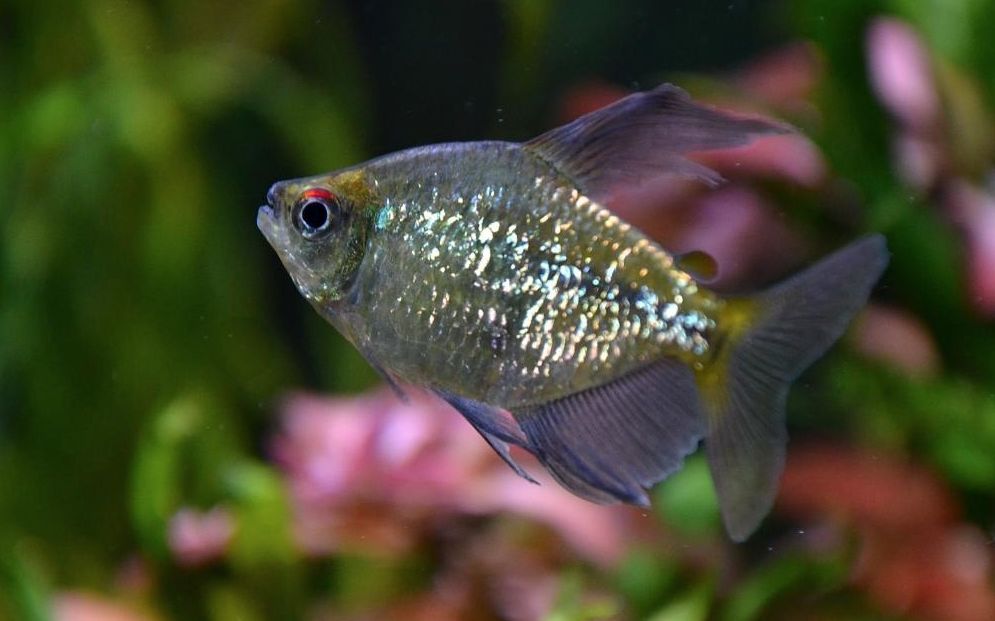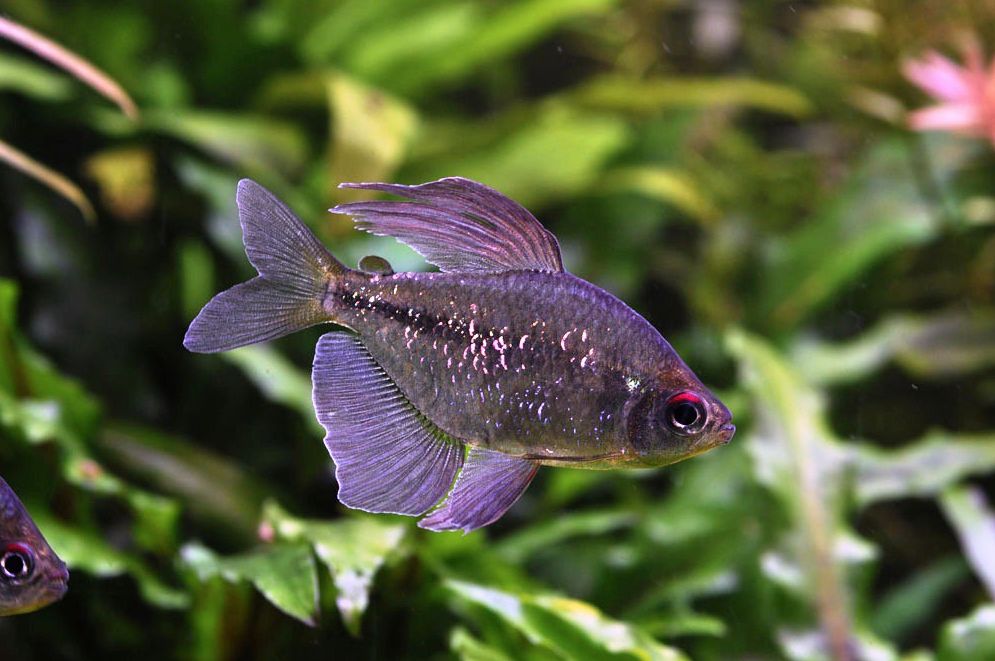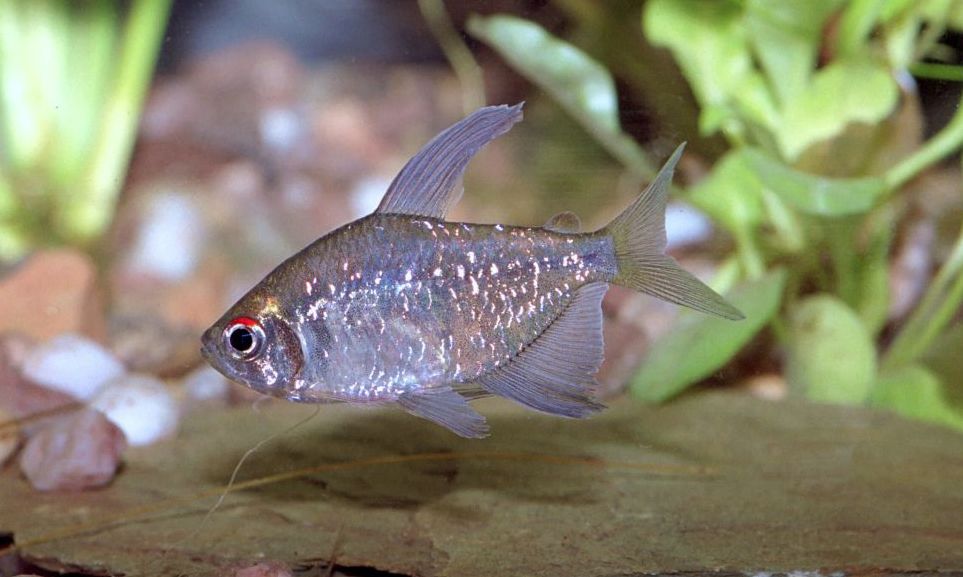The diamond tetra (Moenkhausia pittieri) is a captivating species from the Characidae family, known for its striking opalescent scales that shimmer beautifully in dim lighting. However, it’s important to note that juvenile diamond tetras have a more muted coloration, so patience is key to fully appreciating their vibrant hues. As an active and sociable fish, the diamond tetra can be an excellent addition to a well-maintained community aquarium.

Contents
Habitat in the wild
The diamond tetra (Moenkhausia pittieri) is a vibrant member of the Characidae family, commonly referred to as characins. This family is one of the largest groups of freshwater fish, encompassing a wide range of species with diverse shapes, sizes, and colors, primarily found in South America, Central America, and Africa.
Originating from the coastal area of Lake Valencia in Venezuela, specifically around the Aragua and Guacara rivers, diamond tetras thrive in this unique ecosystem. Lake Valencia, the second largest lake in Venezuela, is situated between two mountain ranges. Unfortunately, the lake suffers from poor water quality due to pollution from human activities, agriculture, and industrial processes. This has led to significant eutrophication, characterized by excessive nutrient runoff that causes harmful algal blooms. Research indicates that fish species diversity in this region has declined by nearly 60% since the mid-20th century.
Diamond tetras naturally inhabit densely planted areas of the lake and its slow-moving tributaries. They are often found among rich aquatic vegetation, including plants like java moss, cabomba, and amazon sword plants, which provide essential cover, protection, and foraging opportunities.
In terms of water flow, diamond tetras can thrive in both slow-moving and moderately flowing waters. They are social fish that prefer to swim in shoals, feeling more secure and displaying natural behaviors when kept in groups of six or more.
Description
Physical Characteristics
The diamond tetra features an elongated and slightly compressed body shape, common among many tetra species. Its base color is a striking silver with a translucent sheen and a subtle yellowish hue. This shimmering silver backdrop highlights the fish’s distinct features, particularly its iridescent scales. Each scale reflects light, creating a sparkling effect reminiscent of diamonds. It’s important to note that only adult diamond tetras display this vibrant coloration; juveniles appear much paler.
The pectoral fins are transparent and colorless, while the other fins exhibit a lovely violet-blue tint. Additionally, the top of the diamond tetra’s iris is adorned with a red hue, adding to its overall allure.
Size and Lifespan
In their natural habitat, diamond tetras can grow up to 2.4 inches (6 cm) long. However, in a home aquarium, they typically reach a maximum size of about 2 inches (5 cm). Individual sizes may vary slightly due to environmental factors.
With proper care, diamond tetras can live several years, often reaching an average lifespan of 5 years or more in captivity. Key factors influencing their longevity include water quality, diet, tank size, and general health. Maintaining a well-kept aquarium and providing a balanced diet are crucial for ensuring their well-being.
| Characteristic | Description |
|---|---|
| Scientific Name | Moenkhausia pittieri |
| Common Name | Diamond Tetra, diamond fish |
| Family | Characidae |
| Native Habitat | Venezuela |
| Size | Approximately 2 to 2.5 inches (5 to 6 cm) |
| Lifespan | Up to 5 years or more in captivity |
| Body Shape | Elongated and slightly compressed |
| Color | Silver base color with yellowish hue |
| Scale Pattern | Diamond-shaped, iridescent scales |
| Stripe | Dark horizontal stripe along the body |
| Temperament | Peaceful and sociable |
| Preferred Water Parameters | pH: 6.0 to 7.5, Temperature: 72°F to 79°F (22°C to 26°C) |
| Diet | Omnivorous – live or frozen foods, flakes, pellets |
| Breeding Behavior | Scatter eggs among plants, minimal parental care |
| Compatibility | Peaceful and suitable for community aquariums |

Difficulties in keeping
Keeping diamond tetras is relatively easy, especially for those with some experience in aquarium husbandry. These fish are well-known and widely bred, which means they are often adapted to a variety of local conditions, making them a great choice for many aquarists.
Care and keeping in a tank
Diamond tetras are inherently schooling fish, making them best suited for a spacious community tank. To create an ideal environment, aim for a setup with a thickly planted perimeter, floating plants for cover, dim lighting, and a dark-colored substrate.
It’s recommended to keep at least six diamond tetras together. This group size allows you to fully appreciate their beauty as they swim in unison, particularly in tanks with opaque lighting. A larger group promotes confidence and activity, enhancing their overall well-being.
In a community of 10 to 15 diamond tetras, you’ll witness even more fascinating behavior. Males will often display themselves to females by spreading their tail fins and shimmering their scales, which may take on a darker hue with a bronze tint during these displays. Keeping diamond tetras in groups not only reduces stress but also brings vibrant life to your aquarium.
Tank size
When choosing the appropriate tank size for diamond tetras, it’s essential to consider their natural behavior, space requirements, and preference for living in groups. A larger tank not only offers more swimming space but also helps reduce aggression and enhances the overall well-being of the fish.
For a group of diamond tetras, a minimum tank size of 20 gallons (75 liters) is recommended. This size provides ample room for swimming and allows the fish to establish territories while engaging in their natural behaviors. If you plan to keep a larger group or add other species to the aquarium, consider opting for a tank of at least 30 gallons (113 liters) or more. This size will accommodate a larger diamond tetra community or a diverse tank setup.
Always remember that the tank size should be proportional to the number of fish and their specific needs.
Tank decor
While diamond tetras do not inhabit the Amazon River, they can thrive in an aquarium designed to mimic an Amazon biotope. This setup combines dim lighting and black water, which enhances their vibrant coloring beautifully.
To create an authentic environment, use river sand as the substrate and incorporate branchy driftwood or snags for added structure. Additionally, adding several handfuls of dried leaves, such as those from beech or oak trees, will complete the natural biotope aesthetic and provide beneficial tannins to the water.
This type of environment not only showcases the stunning appearance of diamond tetras but also promotes their natural behaviors and overall well-being. Including compatible species like small catfish or other peaceful tetras can further enrich the community and enhance the biotope experience.
Water parameters
Maintaining the right water parameters is crucial for the health and happiness of diamond tetras. Here are the recommended values to ensure they thrive:
- Temperature: Diamond tetras prefer water temperatures between 72°F and 79°F (22°C to 26°C).
- pH Level: Aim for a slightly acidic to neutral pH range of 6.0 to 7.5.
- Water Hardness: These fish can tolerate a moderate range of water hardness, ideally between 5 and 15 dH (degrees of hardness), with a preference for slightly softer water.
It’s essential to regularly test and maintain low levels of ammonia, nitrite, and nitrate in the aquarium. Both ammonia and nitrite should be at 0 ppm (parts per million), while nitrate levels should remain below 20 ppm. Regular water changes and effective filtration help achieve these goals.
Diamond tetras thrive in clean, well-filtered water. Invest in a good filtration system and perform water changes of about 20% every 1-2 weeks. Additionally, promptly remove debris and uneaten food to maintain high water quality.

Diet
In their natural habitat, diamond tetras feed on small insects and invertebrates that live in or fall into the water. Thankfully, these fish are easy to feed and are omnivorous, enjoying a variety of food options.
A balanced diet for diamond tetras should include high-quality flakes as the staple food. Supplement their diet with live or frozen options, such as bloodworms and brine shrimp, to enhance their nutrition and encourage natural behaviors.
It’s also important to consider their potential to nibble on aquarium plants. To counter this, provide vegetable supplements, like spinach leaves or commercial flakes that contain plant ingredients, ensuring they receive a well-rounded diet.
As a general guideline, feed your diamond tetras small amounts once or twice a day, ensuring they consume all food within a few minutes. By offering a diverse diet, you’ll promote their health and vibrancy, making them a lively addition to your aquarium.
Tank mates
Diamond tetra is a good choice of fish for a community tank. It is quite appealing and peaceful fish, the males grow to be quite large. Diamond tetra is a good tank mate for most all of live-bearing species (platy, molly, swordtail), zebrafish, Odessa barb, rosy barb, congo tetra, tiger barbs and so on.
Are diamond tetras aggressive or fin nippers? Though the fish has a reputation of the one that nips fins, such behavior can be corrected as a rule by keeping the fish in a school of at least 6-8 species. When you keep this number of species in a group, any fights they have happen inside the group without hurting any other fishes in the tank.
This fish like almost all tetra species feels more comfortable together with other fishes of its kind and usually they are quite timid if there are not many of them in a tank.
Gender differences: male vs female
Understanding the differences between male and female diamond tetras is essential for aquarists, especially those interested in breeding.
Males are typically larger, more brightly colored, and thinner than females. When in breeding condition, males exhibit large, vibrant abdominal, dorsal, and anal fins. Their bodies display a more saturated violet tint, which contrasts with the subtler coloration found on females.
Females are slightly smaller and less vividly colored, featuring fewer scales across their bodies. Their dorsal fin is more rounded, and their other fins are generally shorter than those of males. Females also have a faint greenish-gray lateral stripe that begins at the base of the tail fin and runs along their body, a feature that is often less pronounced or absent in males. Additionally, the fatty fin on females has a pale pink hue.

Breeding
To get the offspring put a couple of diamond tetra species into a separate volume of 10-15 liters capacity.
Water in the spawning tank should be soft and acidic in the range of pH 5,5-6,5, GH 1-5. It is recommended to maintain the water temperature at about 26-27 °C during the spawning. It is desirable to put the breeders separately for 6-8 days before spawning and feed them high with crustaceans and other live food kinds.
To prevent eating the eggs by the fish cover the spawning tank bottom with a net. You may also use bunches of small leaved tank plants for this purpose. The tank lighting should be dim and scattered. It is good to use natural subdued light from the window in this case.
It is better to put the diamond tetra in the spawning tank in the evening. If the fish are ready to spawn, they will start laying eggs the very next morning. Sometimes the spawning is delayed for 2-3 and more seldom for 5 days and the female hides from the male among the tank plants.
As a rule this delay is due to the fact that the eggs inside the female’s abdomen aren’t ready yet. In this case to trigger the spawning process you should add 1,0-1,5 liters of fresh soft water with temperature T= 29-30 °C. During the spawning male haunts the female actively and makes her lay eggs. This takes about 1,5-2 hours, sometimes more.
It depends on how ready the diamond tetra are for spawning and their physical condition. Usually the female lays 350-400 eggs from which only less than 40-60% are fertilized during the first spawning.
After the spawning is over, remove the breeders from the tank as well as the tank plants and the net (after removing the eggs from them). To prevent bacterial and fungi infection add some methylene-blue into the tank water.
Shadow the tank, but continue aerating the water. Or you can do it another way: renew 60-70% of the tank water with the fresh one of the same composition and temperature. This will also increase the amount of healthy and properly developing eggs in the tank.
The transparent diamond tetra larvae appears from the eggs approximately in a day at water temperature T= 26-27 °C. They lay on the tank bottom or stick to the volume walls.
On the 6th day the juveniles start to swim. They are large, dark colored with cross hatching and enduring. Feeding them is easy: give the juveniles infusorian during the first two days. Provided with such feeding the offspring grows by leaps and bounds.
A week later you can feed them with crustacean larvae, artificial micro food and chopped tubifex. Provided with high and proper feeding juveniles become 1 cm long on the 20th day of their life, but at that they still swim very little.
At the age of 1 month the juveniles get the shape and the coloring of their parents. Now this is the time to put them into a nursery tank.
Shortly before this, start gradually increasing the water hardness (this is necessary for the juveniles to develop properly) and make other water parameters of the spawning and nursery tank equal, by adding 1-2 glasses of water from the tank where the breeders live every day.
It is convenient to combine this process with feeding, by mixing filtered off plankton and water from the tank in a glass and then pouring the mixture into the spawning tank. By the age of 6-7 month old the young diamond tetra fish has all the distinctive features of adult species down to the gender dimorphism and they are ready to breed themselves.